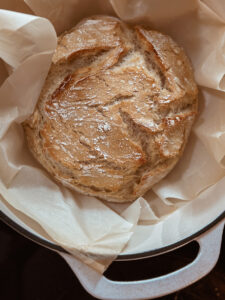You can complain because roses have thorns, or you can rejoice because thorns have roses.”
-Ziggy by Tom Wilson
Apart from the flowery, beautiful sonnets and songs written down through the ages about roses, I often find the more “common language” quotations the most enjoyable. If you were here a few weeks ago and learned, perhaps, some new things about planting and cultivating roses, you may very well have at least one lovely plant turning out its colorful bounty. If your roses are of the strains that are considered either “antique” or “old garden roses” (or those developed more recently with extra attention not to losing the magic of scent) you may also be wondering how you can preserve both the color and perfume of roses. You’ve come to the right place!
I should warn you – at no time will I advocate cutting perfect blossoms and pulling all the gorgeous petals off them before they’ve even had a chance to stand in a vase of water for a while and shine for you. I’ve never had the heart to do it (all the good instructional books and articles aside) and I don’t believe it’s necessary. There are perfectly good things like potpourris, rose petal confections and crafts that are just as nicely served by petals that fall gently by themselves or at the slightest touch from full-blown roses, whether they’ve been cut and brought inside, or left to finish their enjoyment of the sun and rain outside and produce the precious “hips” (more on those later).
At this point, I wish I had written Part II sooner or given you a heads-up to start drying your pieces of orange rind when the Navels were in season (you can still use Valencia rinds – they’re just harder to get off the fruit and I’m not sure they have the same amount of essential oil). I tear or cut mine into quarter size pieces or cut them in strips and set them out on paper towels after a brief shake in a cloth bag of ground Orris root, which is a fixative. Your rose petals will be treated the same way. At no time, heat them. Yes, it is possible to dehydrate rose petals or anything else in a dehydrator or an oven with the pilot light on, but you must recognize that what provides the scent is the essence oils and those are volatile; i.e. they evaporate off all too quickly in heat. You could be left with lovely, colorful crispy things that have little or no scent.
Speaking of color, understand that the color of any rose petal (or citrus rind) that you dry even gradually will darken. For this reason, the pinks & reds of your roses will do best; the whites and cream less well; and for citrus, those oranges, tangerines and even grapefruit work well but the lemons & limes are best left out of the mix. Next Autumn, I’ll try to remind you to start saving bits of tangerine rinds for the following year’s potpourri, alright? Now, here’s a basic recipe. Proportions are up to you and what you have available, but the basic thing is making sure that both your rose petals and citrus rind pieces have been “fixed” with the Orris root. The scent will still be nice without it, but won’t last nearly as long. This recipe also requires the use of either two kinds of essential oils or their equivalent in dried leaves from the corresponding plants.
 1 cup dried rose petals
1 cup dried rose petals
1 to 1 1/2 cup dried citrus peels
1/2 tsp ground cinnamon
1/4 tsp ground clove
3-4 drops patchouli essential oil or
1/2 cup dried patchouli leaves
2 drops sandalwood essential oil or
1/3 cup dried sandalwood chips
This recipe produces a wonderfully spicy mix, but if you make it and wish to vary the proportions, by all means, as with all cottage crafts and art, make it suit you! You certainly won’t hurt my feelings if you change it, or for that matter, like it so much that you multiply the recipe and claim it as your own. I personally have made soap with all essential oils that approximate the scent of this, and it has never gone unappreciated when presented as a gift. That said, there were at last count more than two hundred sites I found that had their own rose potpourri recipes, and I find myself sighing, “so many things to try, so few rose petals!”
Save a few though, assuming no pesticides have been used, for these ideas:
- a fresh rose petal in each cell of an ice cube tray, filled with water or lemonade and frozen, makes a beautiful garnish floated in light summer beverages or cocktails
- fresh rose petals dunked in a cooled “simple syrup” (1 part sugar to 1 part water boiled heated until the sugar completely dissolves) and then spread in a single layer on a cookie sheet in the freezer make beautiful cake decorations or pretty ice cream garnishes
- candied fresh rose petals (even prettier!) are made with dunking each petal into a whipped egg white (you may want to use pasteurized eggs) and then into granulated sugar. Stored in the ‘fridge between layers of waxed paper they’re beautiful on almost anything ….well, maybe not steak…or mashed potatoes….or tuna salad ….nevermind.
OK…now the cool part…what to do if you’ve been so good as to use only natural fertilizers (thank you, Messrs Miller and Mast for the horse manure last year) and no chemical pesticides (thank you, God, for the extra Praying mantises this year…they’re amazing!). If you loved looking at your rose bushes outside so much, watching their colors change and eventually drop that what had once been a flower has now become a hip, you have one more decision to make: rose hips for tea or for Winter interest.
Me? I vote for both! Now, mind you, I haven’t gotten outside the problem of the Japanese beetles quite yet, so I don’t have the full cadre of roses that will someday grace this beautiful piece of land; but having had this happy dilemma to solve when I lived in North Carolina and had no less than three dozen antique roses (among them, Gallica officinalis, the Apothecary’s rose) it was an easy decision — the fattest rose hips were gathered, dried (gently, slowly) to later peel and make tea with; the smaller, sometimes odd-shaped on the more modern roses (some as “young” as the 1940’s!) to be dried hanging upside down from the attic collar ties, later often lightly dusted with silver or gold paint to become part of arrangements for the dinner table or decorations on a holiday wreath.
Later this year, I’ll again remind you when it’s time to prune your roses. “The more modern they are, the more drastically they need to be pruned” is the familiar cry from the rose instructionaires. Once again, I think you’ll find I differ from the most popular opinions; but if there’s room for differing, it’s here in the country. With that, I leave you to make the most of the pleasure and gratification one can gain from a plant that offers so much and asks so little…along with yet another “plain language” quotation about roses.
“I once had a rose named after me and I was very flattered. But I was not pleased to read the description in the catalogue: no good in a bed, but fine up against a wall.” – Eleanor Roosevelt



































We have been having an awesome spring here in Fairbanks Alaska.
the wild roses have been blooming in copious quantities. They are a light to medium pink and very fragrant. I have processed the petals to make jelly, syrup, and wine. I also made some rose vinegar which turned a vibrant rose red color and smells like roses. The rose juice is actually a green but add lemon juice and something magic happens…it turns a beautiful deep rose color. The jelly tastes like the roses smell. I have also dried some of the petals. I have put them aside for my granddaughters weddings – whenever that happens. The hugh bush cranberries are setting fruit and the raspberries are in full bloom…..going to be a busy summer.
Linda
Thanks for the ideas – I have lovely old roses and love to look at them – I bring some in, sometimes, but normally just leave them on their bushes. I will have to try some of the recipes you have given.